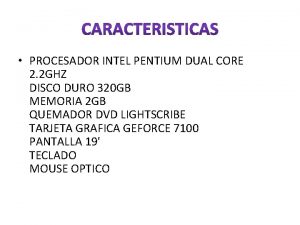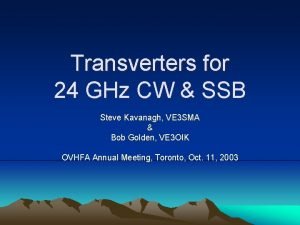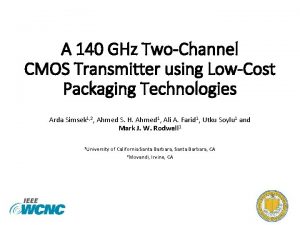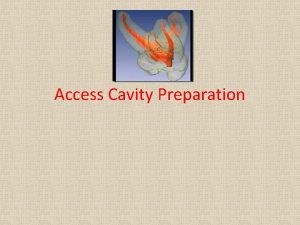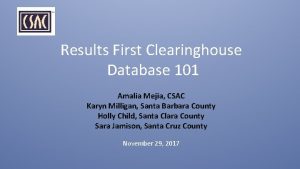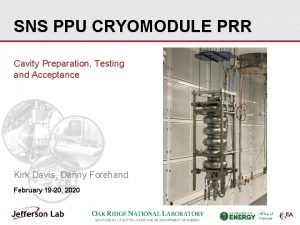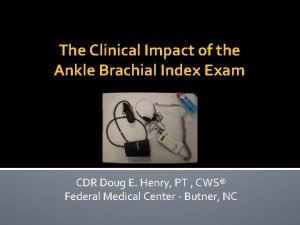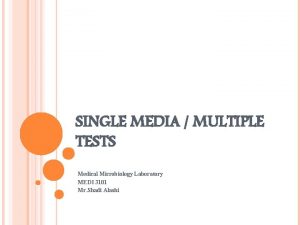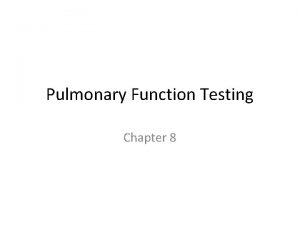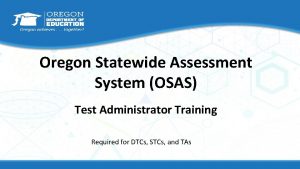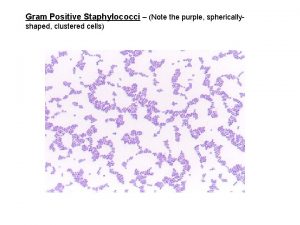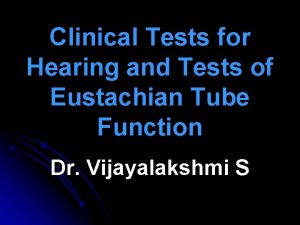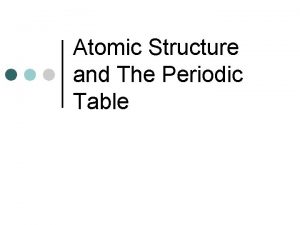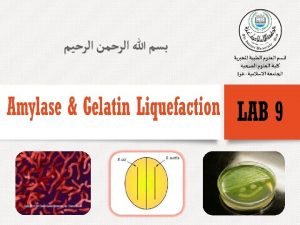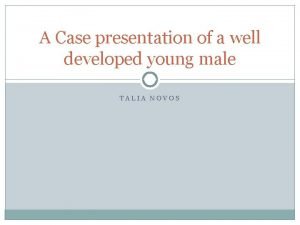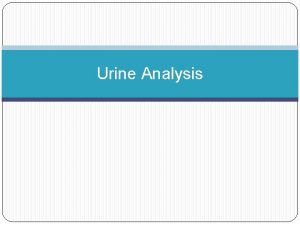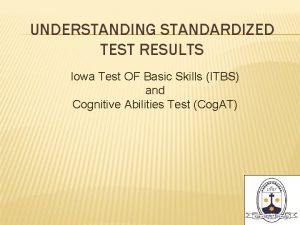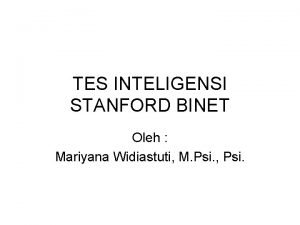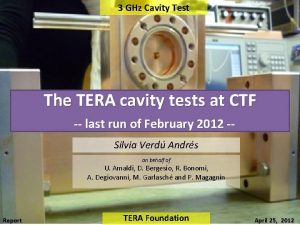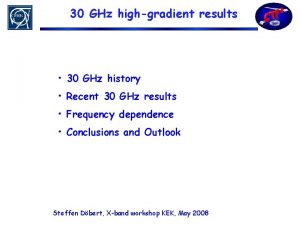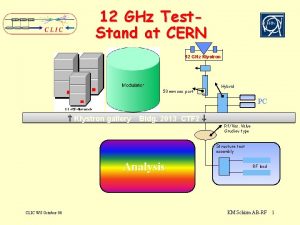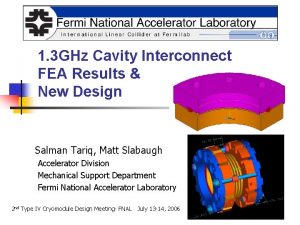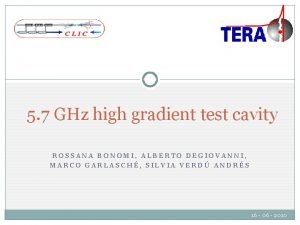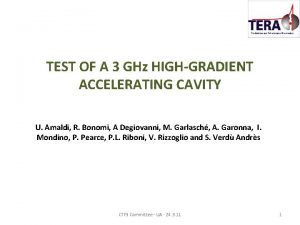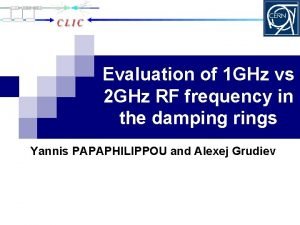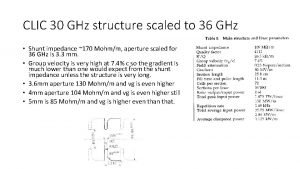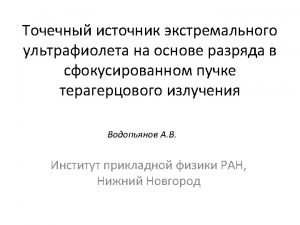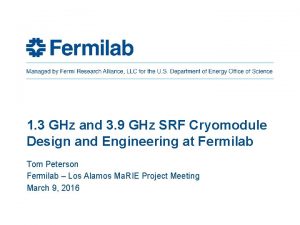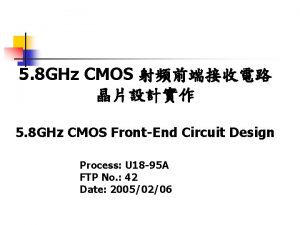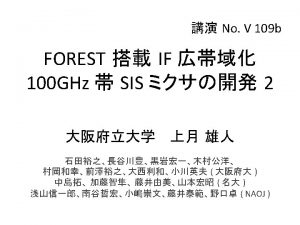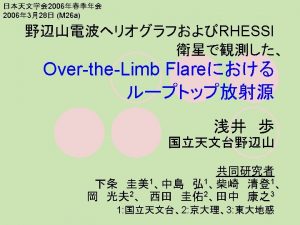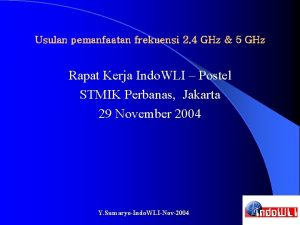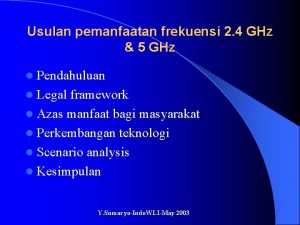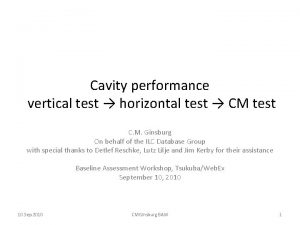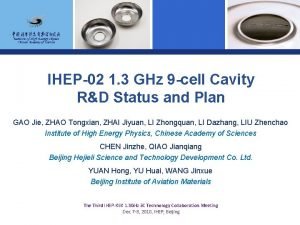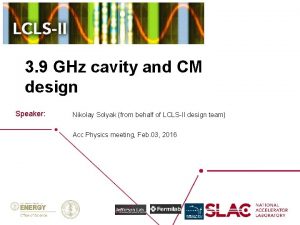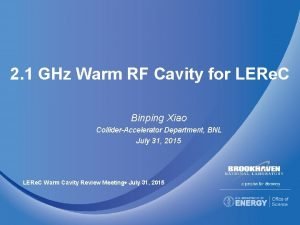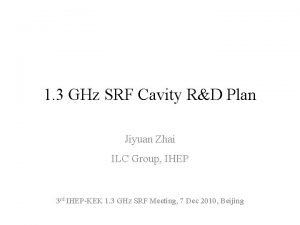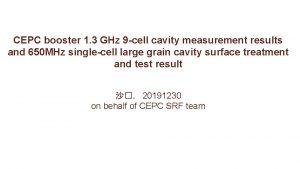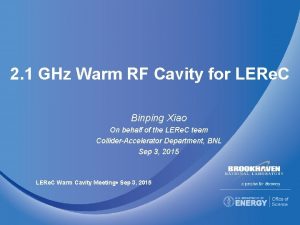3 GHz Cavity Test Results of the first






















![Conditioning 3500 3000 2500 2000 1500 1000 500 0 Peak surface electric field [MV/m] Conditioning 3500 3000 2500 2000 1500 1000 500 0 Peak surface electric field [MV/m]](https://slidetodoc.com/presentation_image/249ce27034699f3d226dc053a3da28f8/image-23.jpg)


















![Bibliography [Degiovanni et al. ] A. Degiovanni et al. , « TERA High Gradient Bibliography [Degiovanni et al. ] A. Degiovanni et al. , « TERA High Gradient](https://slidetodoc.com/presentation_image/249ce27034699f3d226dc053a3da28f8/image-42.jpg)
- Slides: 42

3 GHz Cavity Test Results of the first TERA cavity test at CTF 2 and requests for a next run Silvia Verdú Andrés on behalf of U. Amaldi, J. Bilbao de Mendizábal, R. Bonomi, A. Degiovanni, M. Garlasché and P. Magagnin CLIC meeting TERA Foundation 1 January 13, 2012

Motivation – TERA activities The hadrontherapy community demands compact, reliable accelerators with the appropriate beam performances for tumour treatment with ions.

TERA’s proposal: cyclotron + high-freq. linac = cyclinac CELL COUPLED LINAC l l Cell Coupled Linac Standing-wave structure RF frequency: 5. 7 GHz 2. 5 ms-long pulse at 300 Hz CABOTO (CArbon BOoster for Therapy in Oncology) Silvia Verdú-Andrés 3

TERA’s proposal: cyclotron + high-freq. linac = cyclinac C-band linac Section 1 W 1 C-band linac Section 2 SM 1 W 2 cyclotron W 0 RF rotating joints RF Power sources l l Cell Coupled Linac Standing-wave structure RF frequency: 5. 7 GHz 2. 5 ms-long pulse at 100 Hz Line with 2% momentum acceptance SM 2 Beam dose delivery TULIP (TUrning LInac for Protontherapy)

Motivation – TERA activities The hadrontherapy community demands a compact, reliable accelerators with the appropriate beam performances for tumour treatment with ions. Active energy modulation + High repetition rate: CABOTO – 300 Hz 3 D spot-scanning technique with multipainting moving organs treatment TULIP – 100 Hz + 3 D feedback system TULIP

TERA’s proposal: cyclotron + high-freq. linac = cyclinac CELL COUPLED LINAC l l Cell Coupled Linac Standing-wave structure RF frequency: 5. 7 GHz 2. 5 ms-long pulse at 300 Hz CABOTO (CArbon BOoster for Therapy in Oncology) Silvia Verdú-Andrés 8

TERA’s proposal: cyclotron + high-freq. linac = cyclinac Higher accelerating gradients 120 cost Me. V/u Reduce size and cost! 400 Me. V/u CELL COUPLED LINAC l Cell Coupled Linac l Standing-wave structure l RF frequency: 5. 7 GHz CABOTO (CArbon BOoster for Therapy in Oncology) Silvia Verdú-Andrés 9

TERA’s proposal: cyclotron + high-freq. linac = cyclinac Higher accelerating gradients 120 Me. V/u Reduce size and cost! Common goals for TERA and CLIC Cell shape TERA linacs ES/E 0 Esmax [MV/m] CELL COUPLED LINAC 4— 5 35— 40 200 400 Me. V/u BDRrequired [bpp/m] 10 -6 (reliability) l Cell Coupled Linac CLIC l Standing-wave structures l RF frequency: 5. 7 GHz 2 100 CABOTO 200 10 -6 (CArbon BOoster for Therapy in Oncology) Silvia Verdú-Andrés 10

Our interests • Operation limit for S-band cavities Break. Down Rate BDR • limit described by surface field ES (Kilp. ) • mod. Poynting vector SC • Scaling laws (ES, SC, pulse length, temperature, frequency) • evaluated for X, K and C bands • Applying found limit to future designs • ensure reliable operation • optimize RF structures (efficiency, length, cost) TERA high-gradient single-cells test program

TERA High Gradient Test Program High power test of high-gradient performance single-cell cavities at two different frequencies: • 3 GHz • 5. 7 GHz - One prototype - Preliminary high-power test in 2010. - High power in 2011. - 3 prototypes for testing: - BDR behaviour, - eventual hot spots for BD activity - BD as function of machining procedure (i. e conventional vs. diamond turning) - Under tuning and brazing

3 GHz test: prototype layout • Single accelerating cell (two unsymmetrical half cells) H-coupled to WR 284 waveguide. • Two lateral plates for structure cooling. • CF flanges for data acquisition. Cell Parameters Material C 10100 Copper Dimensional tolerance band 20 μm Surface roughness (Ra) 0. 4 μm

3 GHz test: prototype production Machining (VECA, Italy): Brazing (Bodycote, France) :

Preliminary Test – February 2010 at CTF 3 CLIC collaboration in low power measurements and preliminary high-power testing at CTF 3 in February 2010 BD event Breakdown identification from Faraday Cup signal

Preliminary Test – February 2010 at CTF 3 TERA Limit in copper to surface field by breakdown surface damage Gradient limitations for high frequency accelerators, S. Döbert, SLAC, Menlo Park, CA 94025, USA (2004) … and the cavity was stored under nitrogen for more than one year until September 2011.

Test September 2011

Experimental Set-up at CLIC Test Facility (CERN) o Rf circuit: klystron no. 30, 3 GHz, 50 MW peak power o Vacuum station (ion pump): 10 -8 mbar o Cooling system: thermalized water (30°C), constant water flow (5 L/min) o Diagnostics: • • Faraday cup Incident and reflected RF power (amplitudes and phases) Vacuum gauge Temperature of cavity and coolant (thermistors and Pt 100, respectively) o Remote control of the incident RF pulse performaces o Automatic data acquisition system

from klystron 30 RF window vacuum system 3 GHz TERA single-cell cavity bidirectional coupler towards 3 GHz TERA single-cell cavity

cavity vacuum port aside Faraday cup from klystron 30 vacuum port upstream cavity from klystron 30 3 GHz TERA single-cell cavity vacuum port aside Faraday cup vacuum lecture cavity

cooling system PT 100 out in out from klystron 30 thermistors in

Experiment timeline ES = 350 MV/m Circulator installation (*) No availability to supervise test so run at low field (interesting for TERA applications) (+) Scaling laws evaluation About 250 RF hours (total: ~ 106 seconds), equal to 4. 5 million RF pulses which led to more than 3000 breakdowns used to condition 1 dm 2 of copper surface.

RF pulse characteristics -- Normal operation - « dynamic » stored energy pulse length estimated reflected RF pulse (12 -20% of power in b ~0. 9) incident RF pulse measured reflected RF pulse field emission current signal (< 8 m. A peak within 2. 5 ms-long pulse) negative current: electrons!

RF pulse characteristics -- Normal operation -- -- Breakdown - « dynamic » stored energy pulse length a) reflected power increase: estimated reflected RF pulse (12 -20% of power in b ~0. 9) breakdown! incident RF pulse measured reflected RF pulse field emission current signal b) field-emission current burst: (< 8 m. A peak within 2. 5 ms-long pulse) 0 0 negative current: electrons! electrons positive ions
![Conditioning 3500 3000 2500 2000 1500 1000 500 0 Peak surface electric field MVm Conditioning 3500 3000 2500 2000 1500 1000 500 0 Peak surface electric field [MV/m]](https://slidetodoc.com/presentation_image/249ce27034699f3d226dc053a3da28f8/image-23.jpg)
Conditioning 3500 3000 2500 2000 1500 1000 500 0 Peak surface electric field [MV/m] S breakdown events -- accumulated breakdowns with RF-on time -- 0 0. 5 1. 5 RF on time [Ms] 400 350 300 250 200 150 100 50 0 0 1 0. 2 0. 4 0. 6 RF-on time [Ms] 0. 8 1 About 250 RF hours (total: ~ 106 seconds), equal to 4. 5 million RF pulses which led to more than 3000 breakdowns used to condition 1 dm 2 of copper surface.

Conditioning -- field enhancement factor b -The field enhancement factor b after “conditioning” is about 40 (assuming f = 4. 5 V). After conditioning 1/Es [m/V] -5 log(I/Es 2)[log(A/(V/m)2)] 0 1 E-09 2 E-09 3 E-09 -10 -15 -20 -25 -30 "Fowler-Nordheim plot" 4 E-09 5 E-09

BDR measurements of the last 2 days of the test -- Compared to measurements in 2010 -- 22 bd, 1. 5 h 6 bd, 4. 6 h 0 bd, 8. 3 h 1 bd, 5. 6 h

BDR measurements of the last 2 days of the test -- Breakdowns identified from FE current burst or reflected RF energy --

BDR(Field Emission Current Burst)/ BDR(Reflected Energy) -- field emission current burst OR reflected RF energy? -100 90 280 k. W - Tp=2. 2 us, down 80 600 k. W - Tp=1. 0 us 70 600 k. W - Tp=2. 2 us 60 405 k. W - Tp=2. 2 us, up 50 280 k. W - Tp=2. 2 us, up 40 405 k. W - Tp=2. 2 us, down 30 600 k. W - Tp=1. 5 us 20 405 k. W - Tp=1. 0 us Power(600 k. W - Tp=1. 0 us) 10 0 0 0. 5 1 1. 5 2 Threshold to Field Emission Current Burst [V] The number of breakdowns identified by a field-emission current burst is extremely sensitive (1 order of magnitude) to the threshold used to define a breakdown event from this signal. Next test: use photomultipliers to detect breakdowns from light emission.

2. 2 ms 1. 5 ms 1. 0 ms

BDR measurements of the last 2 days of the test 0 1. 483 1. 533 1. 583 1. 633 log(E) 1. 683 1. 733 -0. 5 log(BDR) -1 -1. 5 X(t. P) ~ 2 1. 57± 0. 04 BDR (RE) ∝�� �� Test'10 -2 -2. 5 -3 -3. 5 -4 221 234 266 305 Scaling laws: BDR � E 13 21 t. P 1. 6 325 ES [MV/m]

Operation limit to high gradient performance -- Modified Poynting vector Sc power law-- The square root of SC has been scaled to tpulse= 200 ns and BDR = 10 -6 bbp/m X-band TWS X-band SWS 30 GHz TWS A. Grudiev, S. Calatroni, and W. Wuensch, “New local field quantity describing the high gradient limit of accelerating structures”. Phys. Rev. ST Accel. Beams 12, 102001 (2009): http: //prst-ab. aps. org/pdf/PRSTAB/v 12/i 10/e 102001

Operation limit to high gradient performance -- Modified Poynting vector Sc power law-- The square root of SC has been scaled to tpulse= 200 ns and BDR = 10 -6 bbp/m DESIGN A. Grudiev, S. Calatroni, and W. Wuensch, “New local field quantity describing the high gradient limit of accelerating structures”. Phys. Rev. ST Accel. Beams 12, 102001 (2009): http: //prst-ab. aps. org/pdf/PRSTAB/v 12/i 10/e 102001

Operation limit to high gradient performance -- Stress model exponential law-- Other experimental data Defect volume DV [m 3] Dislocation loop radius rloop [nm] [0. 8, 13]*10 -25 [13, 40] F. Djurabekova et al. , “Multiscale modeling of electrical breakdown at high electric fields”. Talk in the International workshop on Mechanisms of Vacuum Arcs Me. VArc, Helsinki, Finland (2011): http: //beam. acclab. helsinki. fi/hip/mevarc 11/presentations/djurabekova. pdf

Operation limit to high gradient performance -- Stress model exponential law-- Other experimental data TERA 3 GHz SCC Test Defect volume DV [m 3] Dislocation loop radius rloop [nm] [0. 8, 13]*10 -25 [13, 40] 2. 9*10 -25 21 Test results are consistent with other experimental data F. Djurabekova et al. , “Multiscale modeling of electrical breakdown at high electric fields”. Talk in the International workshop on Mechanisms of Vacuum Arcs Me. VArc, Helsinki, Finland (2011): http: //beam. acclab. helsinki. fi/hip/mevarc 11/presentations/djurabekova. pdf

Operation limit to high gradient performance -- Stress model exponential law-- Other experimental data Defect volume DV [m 3] Dislocation loop radius rloop [nm] [0. 8, 13]*10 -25 [13, 40] 2. 9*10 -25 21 interest TERA 3 GHz SCC Test results are consistent with other experimental data F. Djurabekova et al. , “Multiscale modeling of electrical breakdown at high electric fields”. Talk in the International workshop on Mechanisms of Vacuum Arcs Me. VArc, Helsinki, Finland (2011): http: //beam. acclab. helsinki. fi/hip/mevarc 11/presentations/djurabekova. pdf

Breakdown Timing within RF pulse 450 k. W, ES= 265 MV/m, tp = 2. 2 ms 6 events 450 k. W, ES= 265 MV/m, tp = 2. 2 ms 1 event 600 k. W, ES=325 MV/m, tp = 2. 2 ms 22 events 600 k. W, tp = 1. 0 ms 12 events

Consequences for TERA Hadrontherapy application: ES = 140 --175 MV/m with tflat-top = 2. 2 ms BDR < 10 -6 bpp/m (requirement) Cavity tests: ES = 265 MV/m with tflat-top = 2. 2 ms BDRmeasured (reflected RF energy) =5· 10 -4 bpp/m

Consequences for TERA Hadrontherapy application: ES = 140 --175 MV/m with tflat-top = 2. 2 ms BDR < 10 -6 bpp/m (requirement) Cavity tests: ES = 265 MV/m with tflat-top = 2. 2 ms BDRmeasured (reflected RF energy) =5· 10 -4 bpp/m BDR measurement at ES = 140 --175 MV/m with tflat-top = 2. 2 ms is important for TERA applications, no need to apply scaling laws.

Consequences for TERA Cavity tests: Hadrontherapy application: ES = 140 --175 MV/m with tflat-top = 2. 2 ms BDR < 10 -6 bpp/m (requirement) ES = 265 MV/m with tflat-top = 2. 2 ms BDRmeasured (reflected RF energy) =5· 10 -4 bpp/m BDR measurement at ES = 140 --175 MV/m with tflat-top = 2. 2 ms is important for TERA applications, no need to apply scaling laws. X=20 BDR ~ 10 -9 -- 10 -7 bpp/m X=10 BDR ~ 10 -6 -- 10 -5 bpp/m For operation at 100 Hz: X Time/event 10 17 hours 15 6 days 20 1. 5 months!

Strategy for February 2012 -- dreamed scenario -- Testing time: 17 days Schedule: - Start + continue conditioning (1+2 days) - BDR measurements at high field interesting for CLIC comparison (2 -3 days, scaling law evaluation) - BDR measurement at low field interesting for TERA applications (12 days) * Dark current measurements at different stages

Summary and Conclusions - Debugged Control and Data Acquisition Systems More diagnostic intrumentation included Some conditioning First interesting measurements of field enhancement factor and breakdown rate, and evaluation of scaling laws However, - Conditioning process has not been completed yet: 3 days - Comparison with scaling laws used by CLIC: 2 -3 days - BDR measurement at TERA field: 10 -12 days at 100 Hz

Acknowledgements We would like to express our gratitude to the CTF 3 group for permission to run experiment in their test facility and technical and scientific support (Gerry Mc. Monagle, Jan Kovermann, Roberto Corsini, Stephane Curt, Stephane Rey, Frank Tecker, Esa Paju, Ghislain Rossat, Wilfrid Farabolini, Thibaut Lefevre, Aurelie Rabiller, etc. ) to prepare and perform the experiment. We also acknowledge the CLIC RF structure development group (Walter Wuensch, Igor Syratchev, Alexej Grudiev, Jiaru Shi, etc. ) for the enriching discussions about the preparation, development and analysis of the test. We are also grateful to Rolf Wegner, who leaded the design, prototyping and first highpower test of the cavity, for his valuable discussions on the continuation of the high power tests. Special thanks go to Alexey Dubrovskiy and Luca Timeo, for their special involvement in the experiment. We also acknowledge Javier Bilbao de Mendizábal and Paolo Magagnin for their precious time spent in long shifts and Eugenio Bonomi for the support on the temperature measurement system preparation. Thanks to Vodafone Italy foundation for the fundings received to produce the test cavity. Thanks also to the CERN PS group and CERN General Services for the technical support.
![Bibliography Degiovanni et al A Degiovanni et al TERA High Gradient Bibliography [Degiovanni et al. ] A. Degiovanni et al. , « TERA High Gradient](https://slidetodoc.com/presentation_image/249ce27034699f3d226dc053a3da28f8/image-42.jpg)
Bibliography [Degiovanni et al. ] A. Degiovanni et al. , « TERA High Gradient Test Program of RF Cavities for Medical Linear Accelerators » . NIM A 657 (2011) 55 -58: http: //www. sciencedirect. com/science? _ob=Miami. Image. URL&_cid=271580&_user=107896&_pii=S 0168900211 008886&_check=y&_origin=&_cover. Date=21 -Nov-2011&view=c&wchp=d. GLz. Vlkz. Sk. Wz&md 5=401347 aa 3 fed 9 fd 2706 dc 8 d 36 b 049 a 94/1 -s 2. 0 -S 0168900211008886 -main. pdf [Wang&Loew] J. W. Wang and G. A. Loew, “Field Emission and RF Breakdown in High-Gradient Room. Temperature Linac Structures”. SLAC-PUB-7684 (1997): http: //slac. stanford. edu/cgi-wrap/getdoc/slac-pub 7684. pdf [Grudiev et al. ] A. Grudiev, S. Calatroni, and W. Wuensch, “New local field quantity describing the high gradient limit of accelerating structures”. Phys. Rev. ST Accel. Beams 12, 102001 (2009): http: //prstab. aps. org/pdf/PRSTAB/v 12/i 10/e 102001 [Djurabekova at al. ] F. Djurabekova et al. , “Multiscale modeling of electrical breakdown at high electric fields”. Talk in the International workshop on Mechanisms of Vacuum Arcs Me. VArc, Helsinki, Finland (2011): http: //beam. acclab. helsinki. fi/hip/mevarc 11/presentations/djurabekova. pdf
 Vertebral cavity
Vertebral cavity Ghz
Ghz 24 ghz transverter
24 ghz transverter From 12 to 140 ghz
From 12 to 140 ghz Dorsal cavity
Dorsal cavity Nine regions of the abdominopelvic cavity
Nine regions of the abdominopelvic cavity Greater and lesser sac
Greater and lesser sac Greater omentum
Greater omentum Trapezoidal access cavity
Trapezoidal access cavity Results first clearinghouse
Results first clearinghouse Test cavity preparation
Test cavity preparation Love tank test
Love tank test Love language test
Love language test Color code personality test
Color code personality test Color blue personality
Color blue personality Abi ratio
Abi ratio Gelatinq
Gelatinq Kligler iron agar results
Kligler iron agar results Pulmonary loop
Pulmonary loop Pig drawing meaning
Pig drawing meaning Osas tide
Osas tide Thomas test results
Thomas test results Microbiology gram stain
Microbiology gram stain Methyl red
Methyl red Nitrate reduction test results
Nitrate reduction test results Starch hydrolysis positive result
Starch hydrolysis positive result Where else have you observed colorful light emissions
Where else have you observed colorful light emissions Sweat test results
Sweat test results Hexagon agility test clockwise time example
Hexagon agility test clockwise time example Schwabach test procedure
Schwabach test procedure Api test microbiology
Api test microbiology Flame test results table
Flame test results table E coli starch hydrolysis test
E coli starch hydrolysis test Cortisol stimulation test results
Cortisol stimulation test results Bile salts in urine
Bile salts in urine Iowa test of basic skills
Iowa test of basic skills Rohacell hero
Rohacell hero Randox health test results
Randox health test results Gene by gene test results
Gene by gene test results Hartman personality profile
Hartman personality profile Penyajian tes binet
Penyajian tes binet Covid test results detected
Covid test results detected Alternate hand wall toss test
Alternate hand wall toss test

